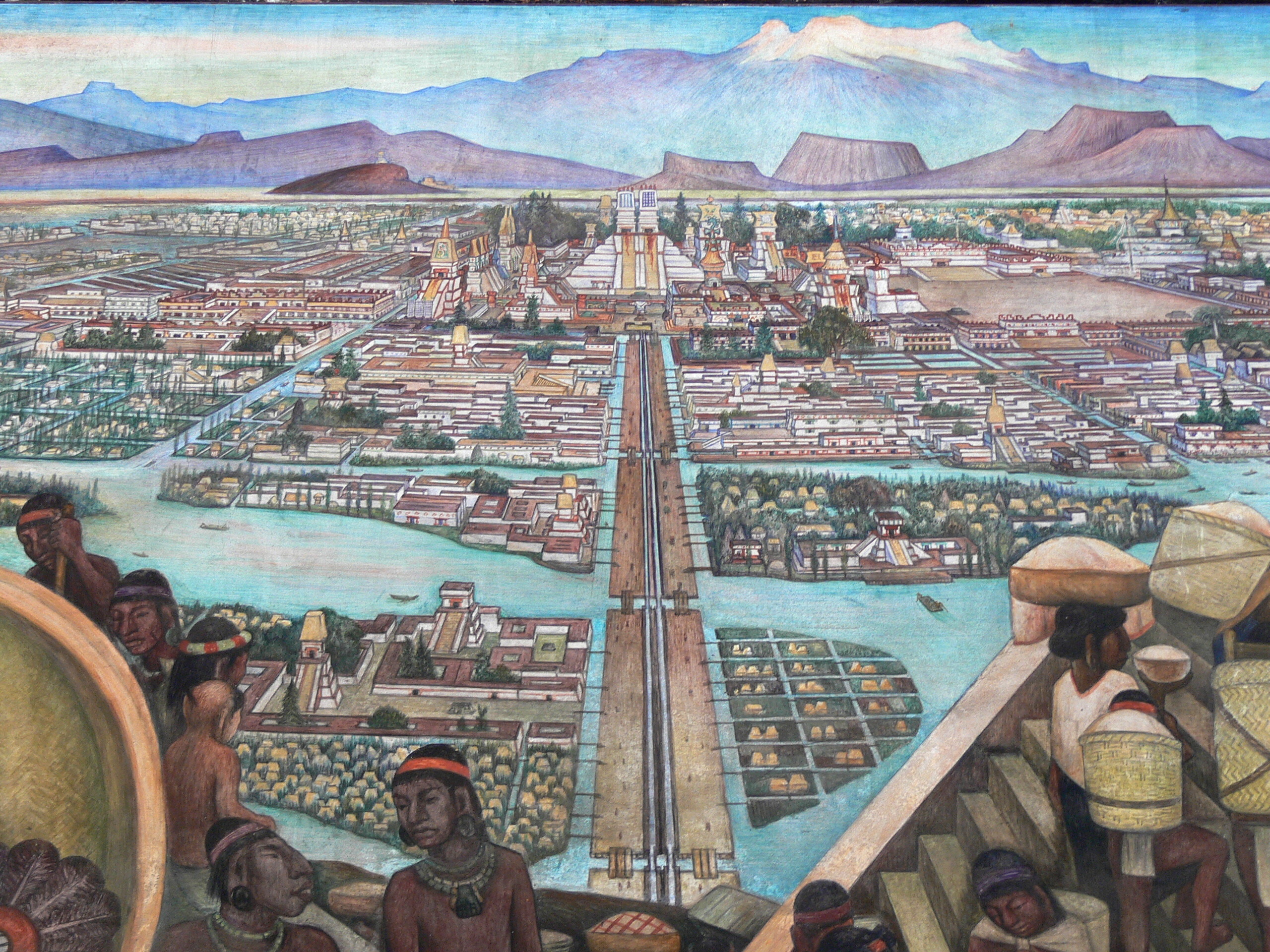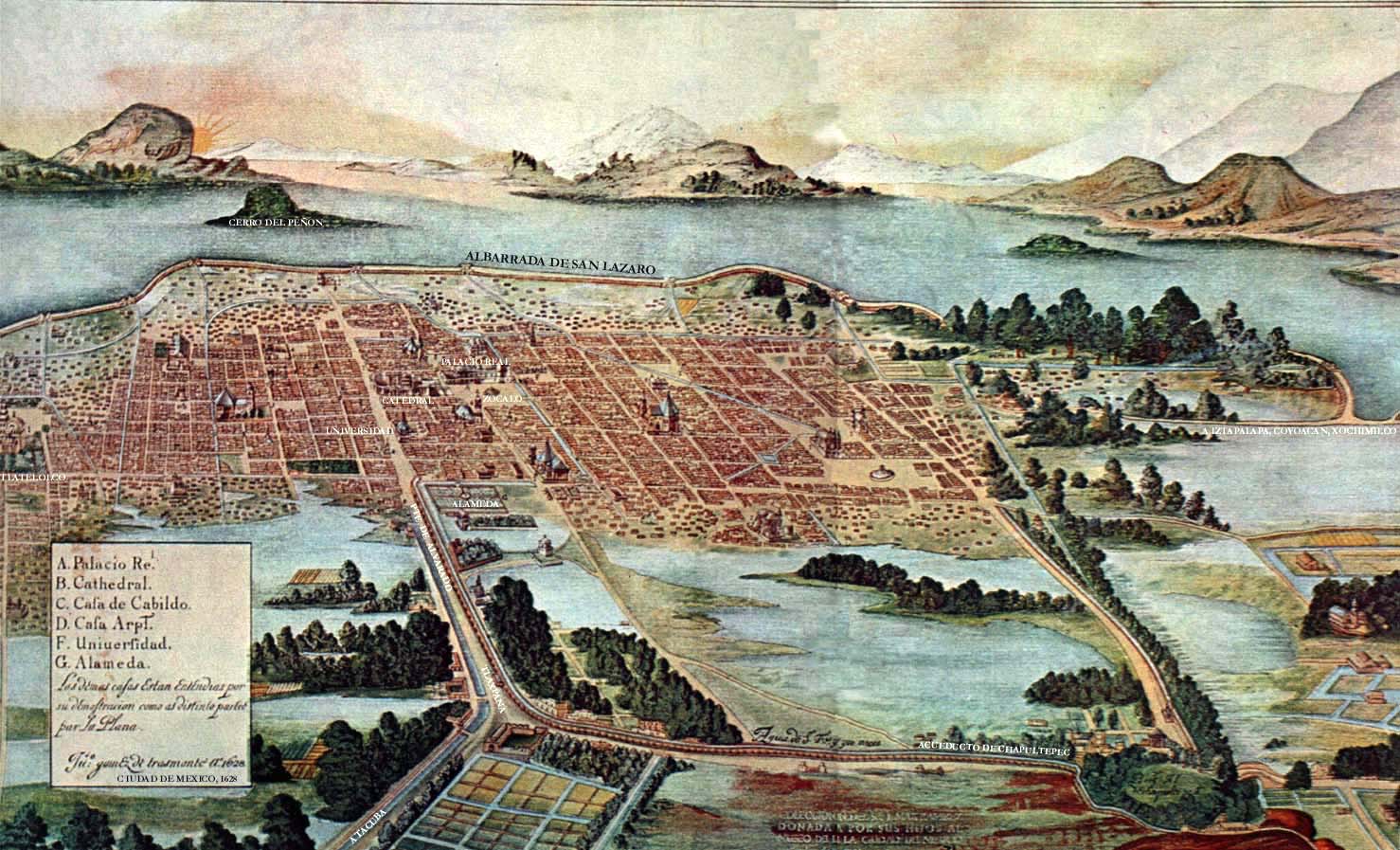
Then there it was, in the valley below. The largest, most glorious city in the Aztec Empire. It was home to 100,000 people, including their ultimate ruler, Emperor Moctezuma II. Tenochtitlán glittered, in ornate splendor, upon a massive island in the midst of an even larger lake. It connected to the mainland by three causeways. It held the Emperor's palace and several huge temples - with the main temple, bigger and more richly endowed than any seen before. Fertile gardens and canals intersected the city at strategic points. Tenochtitlán surpassed all stories told about it on the journey there. It was the greatest display of wealth, ingenuity and beauty in all the Aztec lands. It was more splendid than any European city of the time; smaller only than Constantinople. Hernán Cortés wanted it.
It would take the Spanish two years to take Tenochtitlán, despite forces swelled by the enemies of the Aztec, the Tlaxcalans. Aztec legend had told of the return of the god Quetzalcoátl. It was reported to Spain that, initially, Emperor Moctezuma II had assumed that Cortés was this deity and so had invited him into the city. They were lauded in luxury, feasting on food fit for kings. Moctezuma dressed him with flowers from his own garden, a great honour, though Cortés didn't understand the significance of the gesture. Cortés, along with his 3000 Spanish and Tlaxcalan entourage, were installed in the palace of Moctezuma's own father.
It didn't take long for Cortés to start making demands. At first these were humoured. Gigantic icons of Aztec gods were removed from the central temple; shrines to the Virgin Mary and St Christopher were set up in their place; a seemingly endless supply of gold was produced and handed over as gifts (or tribune, depending on who is telling the story). Cortés responded by seizing Moctezuma in his palace and holding him hostage.
Over the next two years, war raged throughout the city. Cortés left at one point to intercept a Spanish force coming to find and execute him for disobeying orders; but he successfully defeated them and persuaded the survivors to join his own cause. At times, the Aztec repelled the Spanish from Tenochtitlán. Moctezuma died in chains under Cortés's care. The fighting went on, sometimes house to house, street by street. It was never a foregone conclusion that the Spanish would win. On the night of 1 July 1520 alone, 600 Spanish and several thousand Tlaxcalans were killed, while trying to flee the city in the face of a massive Aztec force.
The war continued on the mainland, in pitched battles throughout the surrounding countryside. Without the Tlaxcalans swelling their ranks in their thousands, the Spanish would never have taken Tenochtitlán. When they did, it was as the result of a long, drawn out seige. For eight months, Tenochtitlán was surrounded. Its inhabitants could not cross the lake for supplies. Inside the city, food was rationed, then became scarce. They were bombarded with cannon fire. European diseases, like smallpox, ripped through the population, which had not been exposed to it before (a third of the population of the whole valley died in six months from smallpox). Until, 13 August 1521, the last Aztec Emperor, Cuauhtémoc, surrendered the city.
Cortés moved in immediately. He asked for gold, food and women with fair skin; then he expelled the rest of the Aztecs from the city. Cuauhtémoc was tortured and executed. The population were banned from ever returning to it nor even the surrounding countryside. Then Cortés set about rebuilding Tenochtitlán. It was to be even more ornate and glorious. Spanish buildings and icons to replace the Aztec. It was designed to inspire awe in all that saw it and to impress upon all visitors that the Spanish were the rulers here. Tenochtitlán rose again quickly with splendor on top of splendor. Bigger and better places of worship - Catholic churches and cathedrals now, instead of Aztec temples; more magnificent palaces; grand avenues; beautiful plazas.

There was only one technicality. The Spanish had always had trouble pronouncing Tenochtitlán, with its Aztec consonants strange to their tongue. They asked around and discovered a nickname for the city - the place where the God, Mēxihtli, lives, or, in the Aztec tongue, Mexico. This name they could say more easily and so the city was renamed - Mexico City. Eventually, as the importance of the city spread, it would lend its name to the whole country. Mexico, named after the city, not the other way around.
In the intervening centuries, Mexico City has continued to grow. It's no longer in the center of a lake, as expansion saw that drained and built over. It's been the scene of many of the most momentous events in Mexican history, becoming the nation's capital in 1824. Today, it is home to nearly 9 million people and covers an area stretching 1,485 square kilometres (573 square miles). It is still one of the largest cities in the world, beaten only by Tokyo, Delhi, São Paulo and Mumbai. Successive rulers have continued to pour the lion's share of their country's wealth into this single city. It is the showpiece and the jewel of Mexico.
As a result, it has been nicknamed, 'The City of Palaces', in response to some of its residences. Many of its public buildings or artwork boast the title, 'the biggest in the world'. It hosted the 1968 Olympic Games, with a grand stadium still in evidence. Thousands of tourists and business people visit the city every year. Its vibrancy, creativity and productivity remaining unparalleled throughout Mexico.
Cortés got his wish. The city that he took from the Aztecs is world-reknowned and glorious, though his name is rarely mentioned in the same breath. Yet the Aztecs live on too. Their canals remain and it is a pleasant trip, for locals and tourists alike, to sail along them in a punt. People still marvel at the grand Spanish buildings, but, as archaelogists uncover and restore it, the people admire the Aztec architecture too. Meanwhile the expansion of Mexico City goes on - several skyscrapers are due to be built in the next few years - and the city goes from strength to strength.


No comments:
Post a Comment